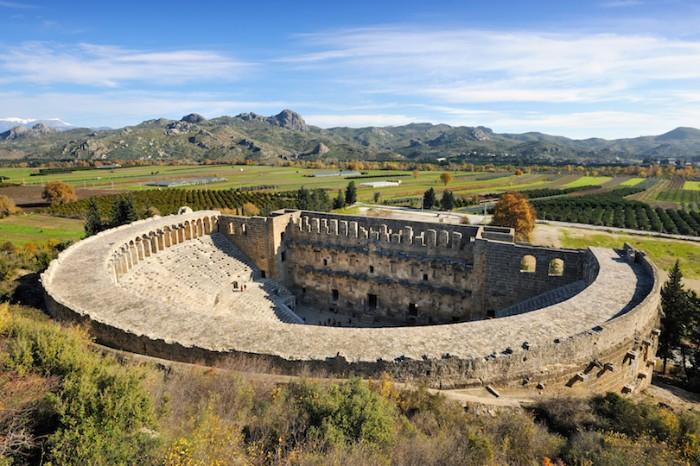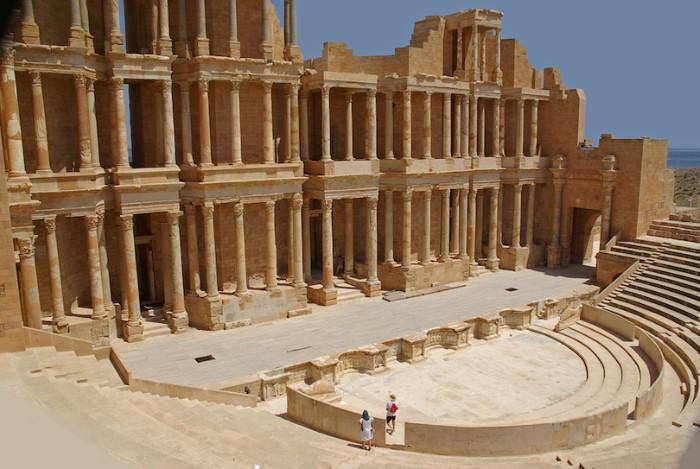Ancient theatres transport us back to a time of grandeur and awe-inspiring tales from the past. From the Mount Olympus of Ancient Greece to the Colosseum in Rome, these monuments remain prestigious symbols of bygone days steeped in history and culture.
But what made them so special? What stories do these structures tell about ancient society and its legacy living today?
Read on to learn more about the fascinating theatres of Greek-Roman antiquity.
Overview of Ancient Greek and Roman Theatres
Ancient Greek and Roman theatres were architecturally unique structures that served as venues for musical performances, religious ceremonies, and dramatic plays.
These structures featured ascending tiers of stone seating, a semicircular orchestra area, and a stage at the front where actors could perform. The most famous examples of ancient Greek and Roman theatre lie in Greece, with the Theatre of Dionysus and the Theatre of Epidaurus being two of the best-preserved examples.
The theatre was an essential part of ancient Greek life, where religious festivals were combined with dramatic performances to be enjoyed by all citizens.
They were places for people to come together to witness a powerful show, connecting them emotionally to their faith and culture. The theatres themselves played an important role in developing Greek and Roman culture.
History of Theatre in Ancient Greece
Theatre in ancient Greece dates back to the 6th century BC when it was first practiced as part of religious festivals and ceremonies. It was believed that performing plays in front of an audience, especially one including gods, would help secure a successful harvest.
The originators of Greek theatre were Homer and Thespis, who wrote the earliest known works for the stage. Theatre in ancient Greece was a form of entertainment that celebrated the city's culture and heritage, telling stories about gods and heroes from Greek mythology.
Over time, theatre evolved into an integral part of daily life in ancient Greece, and the country's theatrical tradition peaked between 500–300 BC. Many famous theatres, including the Theatre of Dionysus in Athens, were built during this period.
These theatres were built in semicircular structures with seating tiers designed for maximum visibility. The audience sat on stone benches and watched plays that could last up to three hours.
Theatre was a popular form of entertainment during ancient Greek-Roman times, and many famous writers such as Sophocles, Euripides, and Aristophanes wrote plays for these theatres.
These plays usually centered around mythology or historical events and were performed by actors wearing masks to distinguish between different characters.
Evolution of Ancient Greek Theatres

The ancient Greek theatres have been around for thousands of years and are one of history's most impressive architectural feats. The evolution of Greek theatres has gone through many stages, beginning with the circular open-air theatre known as the "orchestra" stage.
This was where performances could occur outdoors without needing a roof or walls. In the 4th century BC, theatre designers began using semi-circular rows of seats where people could watch performances from an elevated viewpoint.
After that, a more elaborate seating and stage design system was developed, allowing for greater audience engagement with the performance.
The Roman Empire eventually adopted many aspects of Greek theatre culture and built its theatres based on these designs.
The Roman theatre was generally more elaborate than the Greek, with h seating arranged in a large semi-circle and a stage surrounded by tall columns for acoustics and decoration.
In some cases, the Romans expanded on the traditional Greek theatre design to accommodate larger audiences and to create more sophisticated sets and decorations.
Features of Ancient Greek & Roman Theatres
Ancient Greek and Roman theatres were typically built on hillsides and rose-like auditoriums with tiered seating. The theatres were constructed mainly from stone and had open-air stages that featured a backdrop to create the illusion of a three-dimensional setting.
The audience area was typically divided into the pit (orchestra) and the upper tier (theatre). The pit was a flat area where the actors performed. The upper tier provided seating for the audience, affording them a better view of the stage.
Ancient Greek theatres were also characterized by their use of acoustics to amplify sound and create a more dramatic experience. This was accomplished by carefully placing structures within the theatre, such as a concave wall behind the stage known as the "skene."
The scene was designed to funnel sound outwards and create a reverberation effect.
Examples of Notable Ancient Theatres
One of the most famous and iconic examples of Ancient Greek-Roman theatres is the Theatre of Epidaurus. Built-in the 4th century BCE, this open-air theatre is renowned for its acoustics. Its design was a model for many other ancient theatres throughout the region.
Another example is the Odeon of Herodes Atticus in Athens, constructed in 161 CE. This theatre was known for its impressive stone amphitheater and elegant marble seats. It is still used today to host concerts and other summer events.
The Theatre of Dionysus in Athens is a notable example as well. Built sometime between the 6th century BCE and the 3rd century BCE, this theatre was used for performances of tragedies written by the great playwrights of the time. It is considered the first European theatre, and its design has been used as a model for many other theatres worldwide.
Preservation and Restoration of Ancient Theatres Today

The preservation and restoration of ancient theatres today are very important. Ancient Greek-Roman theatres have been the sites of some of the greatest plays and performances in history, and they are still relevant to our lives today. In addition to preserving their historical relevance, these structures are significant for their architectural importance.
Ancient theatres can be maintained and enjoyed for generations with proper care and understanding. In the past, ancient theatres have been damaged by natural disasters, such as earthquakes, or vandalized by people with no respect for their historical value.
Today, it is essential that these structures are properly cared for to preserve their significance. This involves cleaning and restoring the stone structure, conserving painted surfaces and sculptures, and preserving the original theatre layout.
FAQ
What is Greek and Roman Theatre?
Greek and Roman theatre was the earliest form of theatrical performance. It originated in Greece and spread throughout the Mediterranean during the Classical and Hellenistic eras. It was a popular form of entertainment in Ancient Greece and Rome, with performances ranging from dramatic plays to musical concerts.
What were ancient Greek Theatres called?
Ancient Greek theatres were called amphitheaters, meaning 'two-stage.'' They had a circular or semi-circular orchestra in the center surrounded by tiered seating, known as the caveat.
What are ancient Greek Theatre and its features?
Greek theatre is an ancient form of theatrical performance which developed in the 6th century BCE. It was composed of sung and spoken texts, usually performed by a chorus of actors. Ancient Greek theatre has many prominent features, such as its use of masks, costumes, and props.
Conclusion
Ancient Greek and Roman theatres were integral to the cultural identity of both civilizations. They instilled a sense of civic pride, hosting some of the most important festivals in the ancient world. Over time, these theatres evolved from makeshift wooden structures to monumental edifices with ornate design features. Despite centuries of weathering and tectonic activity, many impressive ancient theatres still exist today thanks to preservation and restoration efforts by dedicated teams of archaeologists and historians.





